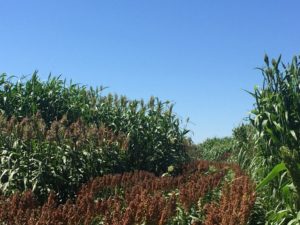by Jourdan Bell, Jourdan.bell@ag.tamu.edu
Ed Bynum, EBynum@ag.tamu.edu
Ted McCollum, Ted.McCollum@ag.tamu.edu
Ronnie Schnell, ronschnell@tamu.edu
The 2017 Texas A&M AgriLife Bushland forage sorghum silage trial consisted of 78 entries including forage sorghum, sorghum-sudangrass, sudangrass, and grain sorghum hybrids under center pivot irrigation. Two corn hybrids were included for comparative purposes. Due to declining well capacities across the Texas High Plains, forage sorghums are a drought tolerant option to meet the increasing silage demands of both the beef feedlot and dairy industries. The large scale of the Bushland trial provides producers and nutritionists the opportunity to compare forage yield and quality parameters for multiple sorghum types under the same production environment. While forage quality requirements vary between livestock class and ration formulation, data from the Bushland trial provides a broad comparison of forage yield and quality in the respective production environment.
The average forage yield in the 2017 trial was 22.3 tons/ac with yields ranging from 27.8 to 12.6 tons/acre. Sugarcane aphids (SCA) were spotted on August 14, 2017 in all hybrids in the trial although not at levels to cause significant damage. Following identification of SCA in the plots, Sivanto was applied aerially at 6 oz/ac (3 GPA) on August 23 and September 4, 2017. In addition to the two insecticide applications, beneficial insects, predominately lady beetles and adult syrphid fly larvae, were observed throughout the trial. Due to the large number of beneficials present in the 2017 trial, it is reasonable to believe that these beneficial insects were providing biological control of the SCA. The seasonal average of all damage ratings reflected good control and non-yield limiting infestation and damage during the 2017 production season.
Photoperiod sensitive (PS) forage sorghums were higher yielding forages, but the forage digestibility was lower. On average, lignin concentrations were lower in BMRs than non-BMRs; however, trial data confirms that the percent lignin and digestibility vary between individual BMR hybrids. Starch conents were lower for the PS hybrids because they did not produce grain, or there was very limited grain production. While producers often choose forage hybrids according to forage type, the 2017 data as well as data from previous years demonstrates that yield and quality overlap across forage types so, is best to evaluate data based on individual performance. The complete report is available at: https://amarillo.tamu.edu/files/2018/01/2017-Bushland-Silage-Final.pdf

Jourdan Bell
Assistant Professor and Extension Agronomist
Dept. of Soil&Crop Sciences
jourdan.bell@ag.tamu.edu